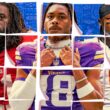It is Saturday morning at San Jose’s SAP Center. The home of the Sharks, at the moment, is the home of the Clemson Tigers and Alabama Crimson Tide, who are still more than 48 hours away from their College Football Playoff National Championship showdown. In rinkside seats, Terry and Donnie Whitcomb sit shoulder to shoulder.
The brothers are dressed in opposing football jerseys as they watch their teams go through the media day motions on the floor below. Terry, dressed in the crimson No. 12 of Joe Namath, says he started school at Alabama in 1964, when Namath led the Tide to a national title. Donnie, dressed in the orange No. 4 of Deshaun Watson — or, wait, he says it’s also for Steve Fuller — was a freshman at Clemson two years later. That fall, on Oct. 8, 1966, the Tigers traveled to Tuscaloosa for the first time in 30 years.
“We beat their ass,” Terry brags, correctly using the Upstate South Carolina pronunciation of “ay-ice.” “We always beat you, right, Donnie? Then we stopped playing.”
“For pretty much our whole lives, Clemson and Alabama never played,” Donnie adds, turning to his brother. “Now we play all the time — every January like clockwork, don’t we?”
“Yep,” big bro responds. “And we’re still gonna beat y’all’s ay-ice.”
Monday night (8 ET, ESPN) marks the fourth straight College Football Playoff matchup between Clemson and Alabama and the third in the national title game. The past five seasons, they have been the two best programs in college football, and that is inarguable. The winner of this latest round in their heavyweight bout might very well seize the upper hand in the “best team of college football’s most competitive era” debate. That is, at least until the next time they meet. Which will probably be one year from now.
“We do our work two different ways, but we always seem to end up right back here together in the big games, don’t we?” Todd Bates says. These days, he’s the assistant coach who oversees Clemson’s vaunted defensive line. But back in the day, he was the anchor of the D-line and team co-captain at Alabama. “I don’t care what team you root for, I think everyone knows that when these two teams in these two uniforms take the field together, that’s as good as it gets. That’s the biggest game in college football.”
Clemson versus Bama has indeed become the embodiment of the modern game. Both universities spend more than $110 million annually on athletics (Alabama is closer to $160 million). Both have dramatically increased their annual football recruiting budgets over the past decade. Both do their work in football facilities that are perpetual construction sites (Clemson’s still-new $55 million football building famously includes a giant slide, putt-putt course and whiffle ball field). Their records the past four seasons: Clemson 54-4, Alabama 55-3. The difference comes from Clemson’s two playoff losses to Alabama against Bama’s one playoff loss to Clemson.
In 2019, college football will celebrate its 150th anniversary in no small part by looking back on the sport’s great, old rivalries: contests that have been played for a century or more, built on a foundation of annual clashes held in classically concrete on-campus coliseums. Highlights of the greatest moments in those series will be recalled via grainy newsreel footage and scratchy AM radio play-by-play calls.
Clemson versus Bama has none of that. The résumé of this rivalry has been written almost entirely within the tiny, five-year timeline of the College Football Playoff, with every game played in sparkling, neutral-site, state-of-the-art NFL stadiums and broadcast around the world via Ultra 4K HD Megacasts against a background of chattering social media commentary.
“You can’t work at Alabama or at Clemson and not have a real appreciation for the history of college football. I mean, look at where I go to work every day. It feels like a museum,” Alabama head coach Nick Saban says. “But it really is remarkable that these two teams haven’t played all that much. Really, hardly at all until now.”
Monday night will be only the 19th time the Tigers and the Tide have met on the field. That’s one fewer than Clemson has played Davidson College and two games shy of Alabama’s all-time series with Howard.
The first CFP meeting — Alabama’s thrilling 45-40 victory in the 2016 National Championship — was only the teams’ second contest since 1975. Prior to Alabama’s victory in September of ’75, they played four in a row in 1966-69 (Alabama won them all), four times in the 1930s (Alabama won all those too) and five times between 1900 and 1913. In the all-time series, Clemson won the first three games, in 1900, ’04 and ’05. The Tigers then lost the next 13, a slump that started on Oct. 16, 1909, during William Howard Taft’s first fall in the White House, and didn’t end until they won the CFP title game rematch on Jan. 9, 2017, a week and a half before Donald Trump was sworn into the job.
Despite the sparseness of head-to-head competition, these two classically Southern teams have a football history that is intricately intertwined. Of Clemson’s past nine head coaches, five played for Alabama, including the school’s holy orange triumvirate: Frank Howard, Danny Ford and current coach Dabo Swinney. Alabama’s perpetually bronzed legend, Bear Bryant, was Howard’s roommate when they played together for the Tide in the 1930s. Bryant mentored Ford when the 30-year-old former Bama player found himself Clemson’s head coach in 1978. Ford was thrust into that job when boss Charley Pell left Clemson for Florida. Pell also played for Bryant on the 1961 national title team. Swinney learned the game from Bryant disciple Gene Stallings as a player on Alabama’s 1992 national championship squad. The Alabama athletic director during those years was Hootie Ingram, who worked under Howard at Clemson and succeeded him as head coach for three seasons, trademarking the famous Tiger Paw logo before returning to his alma mater to work with Bryant.
If Alabama fans don’t believe that’s enough to call Clemson a rival, then perhaps this will do the trick: Clemson football was founded in 1896 by professor-turned-coach-turned-university-president Walter Riggs. He molded the new team, mascot, colors and even the layout of the Clemson campus based on his experiences at his alma mater, Auburn, aka Alabama’s archenemy.
“The ties run so deep between the two schools, it’s crazy,” Swinney says, revealing that he met Frank Howard — the man whose name is on the Death Valley rock that Swinney touches before leading his team down The Hill on autumn Saturdays — when he was 10 years old. In his office, he keeps a photo of Howard eating dinner with his family. “My wide receivers coach at Alabama was Woody McCorvey, who was at Clemson with all those great teams in the 1980s and came to Alabama with Coach Stallings. Woody is my right-hand man now [Clemson’s football administrator]. [Associate head coach] Danny Pearman played at Clemson and came to Alabama with Woody. A bunch of guys did that. If we start listing all the assistant coaches who have gone back and forth, we’ll be here all night. I always knew about Clemson, but those guys really taught me about it. They loved it. So I knew there had to be something to it. I just needed to see it for myself.”
The coach smirks a little as he continues. “The truth is, there are a lot of closet Clemson fans in Alabama and always have been. That was easy to pull off when we never played. Now we’re making life a little rough on them. We’re making them have to choose. And that’s fine by me!”
For example, Swinney’s “second father,” Gene Stallings, likes to drop in to visit his apprentice from time to time. When he does, he dons an orange Clemson jacket as he stands on the sideline at practice. Likewise, Danny Ford used to enjoy wearing the 1973 national title ring he earned as an Alabama assistant coach under Bryant alongside the ’81 ring he won as Clemson’s head coach. No one had a problem with those wardrobe choices six years ago. “If I do it now, people are like, ‘Well, what the hell, Danny?!'” says Ford, who still lives near campus. “It all changed when we started playing each other all the time.”
“Yeah, I wouldn’t call it a house divided,” says Clemson safeties coach Mickey Conn, who played with Swinney at Alabama, as did defensive ends coach Lemanski Hall. He grins as he continues, looking over at Hall, who is eavesdropping nearby. “I would call it many houses divided.”
“That’s the truth,” Hall responds. He was the leading tackler on the Tide’s legendary ’92 defense. This is his first season on his old teammate’s Clemson staff. “I won a ring at Alabama. Now I want to win one at Clemson. I love my alma mater. I always will. But there will be no split loyalties Monday night.”
Maybe not on the sideline or in the Conn, Hall, Bates and Swinney homes. But the homes and hometowns of some of the players might be in for an internal tug of war. Three players on Alabama’s roster hail from South Carolina, and six Clemson players grew up in the Yellowhammer State.
“My mom and my dad are Clemson people, and I grew up wearing Clemson colors, but I’m in crimson now,” says Alabama freshman defensive lineman Stephon Wynn Jr., who grew up in Anderson, South Carolina, the town everyone drives through to get to games in Death Valley. His father, Stephon Sr., played in that stadium as a tight end for the Tigers. “I know they are rooting for me on Monday night, but some of my other friends and family, I don’t know, man.”
That’s the same song recited by many others, such as Clemson’s James and Jacob Edwards, twin brothers from Birmingham suburb Vestavia Hills. In fact, five of the six Alabama-to-Clemson defectors are from the greater Birmingham area, just like the head coach who recruited them. “Most of our family supports us,” says James Edwards, placing extra emphasis on the word “most.” “We’ve managed to convert most of our family. The friends have been harder to bring along.”
Edwards says he made the switch to orange early in his high school days, when Clemson caught his eye with its on-field performance against, yep, Alabama. The story was the same for Alabama freshman punter Skyler DeLong, who grew up in Fort Mill, South Carolina, which sits just below the North Carolina border. “Growing up where I did, you either liked Clemson or South Carolina, but I didn’t root for either one,” he says. Alabama caught his eye in no small part because of its success against his least favorite of the two state schools. “Now I hate Clemson. I get sick of hearing about them. I want to beat them so bad, just so I go home and talk smack to my friends I grew up with.”
One of those friends is Clemson place-kicker B.T. Potter. DeLong and Potter were middle school soccer teammates. When both were cut from their opposing high school soccer teams, they took up kicking. They had the same kicking coach, so they worked out together. As they worked out and their teams played separate schedules, they talked a lot of smack. When graduation came last spring, they chose opposite sides of college football’s greatest new rivalry. This week, the freshmen have been trading smack once again.
As with all things in this new age of Clemson versus Alabama, it comes with considerably higher intensity.
“I think that in order to truly prove that you are a great team, you have to have someone who will push you there,” Saban says Saturday as the Whitcomb brothers watch and listen. “I think about the greatest teams I can remember, and they almost all had someone who was right there with them. That’s why you play or coach football or any other sport: to face the best.”
Ali had Frazier. The Yankees had the Dodgers. Magic had Bird. The Beatles had the Rolling Stones. Alabama has plenty of SEC rivalries to keep it on its toes. But it’s the Tide’s newest nemesis that takes them to the next level each and every January.
“Iron sharpens iron, right?” Swinney says. “Well, if you want to be mentioned in the same sentence with Alabama, you better be pretty dang sharp. I don’t know about making history and all that stuff, but if we have the kind of game Monday night that we’ve had on this stage before, then I think one day people will have to look back on Clemson versus Alabama as one [of] the great ones. I hope we give them the kind of game that makes people have to say that.”
Source:ESPN





